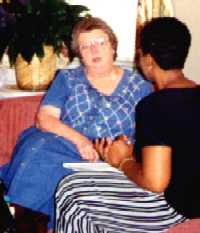 |
August 2000 |
Division of Community Corrections Employee Gives Valuable Gift
RALEIGH- You might have seen a Division of Community Corrections employee on television recently, talking about a gift to save someone else’s life. Nancy Smith, an employee in the personnel section, was featured on NBC 17 news for being a bone marrow donor.
| Smith first heard about the need for bone marrow donors from a radio show and decided she was interested in learning more about the program. In 1994, she participated in a bone marrow drive in Raleigh, at which time blood samples were taken. Two years later she learned she was a tentative match for a recipient. She waited for a phone call, but did not receive any further word until the telephone rang on Christmas Eve 1998, when she learned she was a match for an individual who desperately needed a bone marrow transplant. Smith says she felt as though she had received a gift. "I felt so happy that I would be able to give something to another person who was very sick and needed a part of me that I could give," Smith said. |  Nancy Smith, DCC Personnel, left, talks with NBC 17 reporter for news story about her experiences with bone marrow donation. |
Throughout the process Smith says she had no real fear. "I did have a little hesitation about the surgical procedure used to collect the bone marrow and wanted to know how much pain would be involved, but once I made up my mind to be a donor there was no turning back," she said. "So many people supported and encouraged me – my family, co-workers, members of my church family and friends."
The American Red Cross collected Smith’s bone marrow at Baptist Hospital in Winston-Salem over two days on an outpatient basis for 3-1/2 to 4 hours each day. The procedure used is called Peripheral Blood Stem Cell Collection by Apheresis. "It was much like the kidney dialysis procedure, or the blood donation used to collect platelets," Smith said. "Blood was taken out of one arm, run through a machine that collected the stem cells (baby white cells), and put back into my other arm. This was the first time this collection procedure had been done by the Red Cross from a non-related donor to a recipient. This type donation is performed numerous times for patients by their relatives and by patients themselves for their own use." Recipients sometimes have to have more than one marrow transplant.
Smith donated her bone marrow in October 1999, but was told she could not know all the information about the recipient until one year later. She says, "I was told up front that my recipient was a 57-year-old man who lived ‘somewhere in the world.’ I later was able to determine that my donation was taken personally by one of the Red Cross staff who indicated she had to fly a great distance to reach my recipient."
The bone marrow donor program has been a positive experience for Smith and she wants her colleagues, friends and family to know that it is simple to become part of the bone marrow registry and it is a wonderful opportunity to help another human being. "It is something anyone can consider doing and there are so many needs for all ethnic groups - in the United States and in other countries as well."